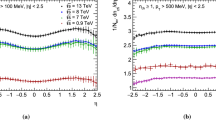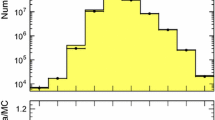Abstract
Multiplicity distributions of secondary hadrons produced in p \( \bar p \) and collisions are very different. There are three types of inelastic processes in p \( \bar p \) scattering. The first one is the production of a shower of secondary hadrons in gluon string decay. The second one is the shower produced from the decay of two quark strings, and the third one is the shower produced from the decay of three quark strings. At the same time, there are just two types of inelastic processes for pp scattering: the shower from the gluon string and the shower from two quark strings. The multiplicity distribution and the average multiplicity of charged hadrons for an energy of 14 TeV are predicted.
Similar content being viewed by others
References
V. A. Abramovskii and O. V. Kancheli, “Redge Branchings and Distribution of Hadron Multiplicity at High Energies,” Pis’ma Zh. Eksp. Teor. Fiz. 15, 559–563 (1972) [JETP Lett. 15, 397 (1972)].
V. A. Abramovskii, V. N. Gribov, and O. V. Kancheli, “Character of Inclusive Spectra and Fluctuations in Inelastic Processes Due to Multipomeron Exchange,” Yad. Fiz. 18, 595–616 (1973) [Sov. J. Nucl. Phys. 18, 308 (1973)].
E. A. Ter-Martirosyan, “On the Particle Multiplicity Distributions at High Energy,” Phys. Lett. B 44, 377–380 (1973).
B. Humpert, “Are There Multi-Quark Interactions,” Phys. Lett. B 131, 461–466 (1983).
T. Alexopoulos et al., “The Role of Double Parton Collisions in Soft Hadron Interactions,” Phys. Lett. B 435, 453–457 (1998).
S. G. Matinyan and W. D. Walker, “Multiplicity Distribution and Mechanisms of the High-Energy Hadron Collisions,” Phys. Rev. D: Part. Fields 59, 034022 (1999).
F. Abe et al., “Double Parton Scattering in Anti-pp Collisions at √s= 1.8 TeV,” Phys. Rev. D: Part. Fields 56, 3811–3832 (1997).
A. M. Snigirev et al., “QCD Status of Factorization Ansatz for Double Parton Distribution,” Phys. Rev. D: Part. Fields 68, 114012-1–114012-3 (2003).
V. L. Korotkikh and A. M. Snigirev, “Double Parton Correlations Versus Factorized Distributions,” Phys. Lett. B 549, 171–176 (2004).
V. A. Abramovskii and H. V. Radchenko, “Full Cross Sections of Hadron Interactions in Model with Few Constituents,” Pis’ma Fiz. Elem. Chastits At. Yadra 6,N5(154), 607–619 (2009).
A. Giovannini, “On a Statistical Generalization of the Multiperipheral Bootstrap,” Nuovo Cim. A 10, 713–722 (1972); A. Giovannini and L. van Hove, “Negative Binomial Multiplicity Distributions in High-Energy Hadron Collisions,” Z. Phys. C 30, 391–400 (1986).
C. Fuglesang, “Review of New Experimental Results on Soft Hadronic Physics,” CERN-EP/88-143.
A. Giovannini and R. Ugoccioni, “Possible Scenarios for Soft and Semi-Hard Components Structure in Central Hadron-Hadron Collisions in the TeV Region,” Phys. Rev. D: Part. Fields 59, 094020 (1999).
I. M. Dremin and V. A. Nechitailo, “Independent Pair Parton Interactions — Model of Hadron Interactions,” Phys. Rev. D: Part. Fields 70, 034005 (2004).
O. G. Chikilev and P. V. Shlyapnikov, “One More Parametrisation of Multiplicity Distribution in Inelastic pp and p Interactions,” Yad. Fiz. 53, 1374–1385 (1991) [Sov. J. Nucl. Phys. 53, 849 (1991)]; O. G. Tchikilev, “Multiplicity Distributions at High Energies as a Sum of Poissonian-Like Distributions,” Phys. Rev. D: Part. Fields 59, 094008 (1999).
G. J. Alner et al., “Antiproton-Proton Cross Sections at 200 and 900 GeV c.m. Energy,” Z. Phys. C 32, 153–161 (1986); M. Bozzo et al., “Measurement of the Proton-Antiproton Total and Elastic Cross Sections at the CERN SPS Collider,” Phys. Lett. B 147, 392–398 (1984); G. J. Alner et al., “A General Study of Proton-Antiproton Physics at √s= 546 GeV,” Phys. Rep. 154, 247–283 (1987); F. Abe et al., “Measurement of the Antiproton-Proton Total Cross Section at √s = 546 and 1800 GeV,” Phys. Rev. D: Part. Fields 50, 5550–5561 (1994); N. A. Amos et al., “A Luminosity-Independent Measurement of the \( \bar p \) p Total Cross Section at √s = 1.8 TeV,” Phys. Lett. B 243, 158–164 (1990); N. A. Amos et al., “Diffraction Dissociation in \( \bar p \) p Collisions at √s = 1.8 TeV,” Phys. Lett. B 301, 313–316 (1993).
D. P. Roy and R. G. Roberts, “Triple-Regge Analysis of pp → pX and Some Related Phenomena — a Detailed Study,” RL-74-022.
N. Amos et al., “Measurement of Small-Angle Antiproton-Proton and Proton-Proton Elastic Scattering at the CERN Intersecting Storage Rings,” Nucl. Phys. B 262, 689–714 (1985); F. Abe et al., “Measurement of Small Angle Antiproton-Proton Elastic Scattering at √s = 546 and 1800 GeV,” Phys. Rev. D: Part. Fields 50, 5518–5534 (1994); M. Bozzo et al., “Low Momentum Transfer Elastic Scattering at the CERN Proton-Antiproton Collider,” Phys. Lett. B 147, 385–392 (1984); N. Amos et al., “Measurement of ρ, the Ratio of the Realto Imaginary Part of the \( \bar p \) p Forward Elastic Scattering Amplitude, at √s = 1.8 TeV,” Phys. Rev. Lett. 68, 2433–2436 (1992).
J. R. Cudell et al., “High Energy Forward Scattering and the Pomeron: Simple Pole Versus Unitarized Models,” Phys. Rev. D: Part. Fields 61, 034019 (2000).
K. Goulianos, “Pomeron Flux Renormalization in Soft and Hard Diffraction,” Phys. Lett. B 358, 379–388 (1995).
A. Breakstone et al., “Charged Multiplicity Distribution in pp Interactions at CERN ISR Energies,” Phys. Rev. D: Part. Fields 30, 528–535 (1984).
R. E. Ansorge et al., “Charged Particle Multiplicity Distributions at 200 and 900 GeV cm. Energy,” Z. Phys. C 43, 357–374 (1989).
J. L. Siegrist et al., “Hadron Production by e + e − Annihilation at Center-of-Mass Energies between 2.6 and 7.8 GeV,” Phys. Rev. D: Part. Fields 26, 969–990 (1982); B. Niczyporuk et al., “Charged Hadron Production in e + e − Annihilation in ϒ and ϒ′ Region,” Z. Phys. C 9, 1–8 (1981).
V. A. Abramovskii et al., Inelastic Interactions at High Energies and Chromodynamics (Metsniereba, Tbilisi, 1986) [in Russian].
N. Armesto et al., “Heavy Ion Collisions at the LHC — Last Call for Predictions,” J. Phys. G 35, 054001 (2008).
Author information
Authors and Affiliations
Additional information
Original Russian Text © V.A. Abramovsky, N.V. Radchenko, 2009, published in Pis’ma v Zhurnal Fizika Elementarnykh Chastits i Atomnogo Yadra, 2009, No. 6 (155), pp. 717–727.
Rights and permissions
About this article
Cite this article
Abramovsky, V.A., Radchenko, N.V. Multiplicity distribution in proton-proton and proton-antiproton collisions at high energies. Phys. Part. Nuclei Lett. 6, 433–439 (2009). https://doi.org/10.1134/S1547477109060028
Published:
Issue Date:
DOI: https://doi.org/10.1134/S1547477109060028




